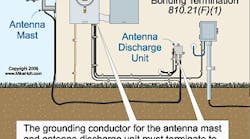Q. What are the NEC grounding requirements for satellite dishes?
A. The first thing required by the NEC is that each lead-in conductor from an outdoor antenna must be provided with a listed antenna discharge unit — located outside or inside the building, nearest the point of entrance, but not near combustible material [810.20]. In addition, the antenna mast [810.15] and antenna discharge unit [810.20(C)] must be grounded per the requirements of 810.21.
Grounding the lead-in antenna cables and the mast help prevent voltage surges caused by static discharge or nearby lightning strikes from reaching the center conductor of the lead-in coaxial cable. Because the satellite dish sits outdoors, wind creates a static charge on the antenna as well as on the cable attached to it. This charge can build up on both the antenna and the cable until it jumps across an air space, often passing through the electronics inside the low-noise block down converter feed horn (LNBF) or receiver. Connecting the coaxial cable and dish to the building grounding electrode system (grounding) helps to dissipate this static charge.
Although nothing can prevent damage from a direct lightning strike, grounding with proper surge protection can help reduce damage to the satellite dish and other equipment from nearby lightning strikes.
The grounding conductor to the electrode [810.21(F)] must be copper or some other corrosion-resistant conductive material (stranded or solid). The grounding conductor isn’t required to be insulated; however, it must be securely fastened in place. The grounding conductor must be mechanically protected where subject to physical damage — and where run in a metal raceway both ends of the raceway must be bonded to the grounding conductor. Installing the grounding conductor in PVC conduit is a better practice. The grounding conductor must be run in as straight a line as practicable. Lightning doesn’t like to travel around corners or through loops.
The grounding electrode conductor must terminate in accordance with (1), (2), or (3).
(1) Buildings or Structures With an Intersystem Bonding Termination. The grounding conductor for the antenna mast and antenna discharge unit must terminate to the intersystem bonding terminal [Art. 100 and 250.94], as shown in Fig. 1. Bonding all systems to the intersystem bonding termination helps reduce induced potential (voltage) differences between the power and the radio and television systems during lightning events.
(2) In Buildings or Structures Without Intersystem Bonding Termination. The grounding conductor for the antenna mast and antenna discharge unit must terminate to the nearest accessible location on the following:
• Building or structure grounding electrode system [250.50].
• Interior metal water piping system, within 5 ft from its point of entrance [250.52(A)(1)].
• Accessible means external to the building, as covered in 250.94.
• Metallic service raceway.
• Service equipment enclosure.
• Grounding electrode conductor or the grounding electrode conductor metal enclosure.
(3) In Buildings or Structures Without a Grounding Means. The grounding conductor for the antenna mast and antenna discharge unit must terminate to the nearest accessible location on the following:
• Any individual electrodes described in 250.52
• Structural steel grounded in accordance with 250.52(A)(2)
The grounding conductor can be run either inside or outside the building. The grounding conductor must not be smaller than 10 AWG copper or 17 AWG copper-clad steel or bronze. Copper-clad steel or bronze wire (17 AWG) is often molded into the jacket of the coaxial cable to simplify the grounding of the satellite dish by eliminating the need to run a separate grounding conductor to the dish [810.21(F)(2)].
Where a ground rod is installed to serve as the grounding electrode for the radio and television equipment, it must be connected to the building’s power grounding electrode system with a minimum 6 AWG conductor (Fig 2). Termination of the grounding conductor must be by exothermic welding, listed lugs, listed pressure connectors, or listed clamps. Grounding fittings that are concrete-encased or buried in the earth must be listed for direct burial [250.70].
Q. We are designing a hotel that will use wall-mounted A/C units in each room. Is there a demand factor that we can use for these to allow a smaller feeder, or do we have to use 100% of the load for each?
A. The calculated load for a feeder or service must not be less than the sum of the branch-circuit loads, as determined by Part II Art. 220, as adjusted for the demand factors contained in Parts III, IV, or V [220.40]. Nothing in Parts III, IV or V provides a demand factor hotel air conditioner, so they must be taken at 100%.
Q. We have a very large structure that is fed from multiple utility transformers. How do we go about grounding the services?
A. The only specific requirement is that when separate services, feeders, or branch circuits supply a building, the same grounding electrode must be used [250.58].
Q. I am remodeling a log cabin and have to splice the feeder circuit. A junction box would look absolutely hideous in a log cabin, so I am hoping I can conceal the splice without a box. Can I?
A. No, you can’t. A box must be installed at each splice or termination point, except as permitted in 300.15 (A) through (M) [300.15]. Nothing in (A) through (M) waives the requirement for aesthetic reasons.
Q. I have a 600A service disconnect that supplies four 200A panels downstream. I left the service disconnect with parallel 350kcmil conductors, then went to a wireway and used 3/0 to each of the panels. The panels are main lug, and I'm being told they must be main breaker, even though the taps are less than 25 ft. Can you help me understand this rule?
A. You really have two issues here: overload protection for the conductors and overcurrent protection for the panels themselves. Per 240.21(B), feeder taps without overload protection at the feeder overcurrent device are allowed, but the tap conductors must terminate in a single circuit breaker — or set of fuses rated no more than the tap conductor ampacity in accordance with 310.15 [240.21(B)(2)(2)].
In addition, each panelboard must also be provided with overcurrent protection located within — or at any point on the supply side of — the panelboard. The overcurrent device must have a rating not greater than that of the panelboard, and it can be located within — or on the supply side of — the panelboard [408.36].
Q. Is there a maximum number of duplex outlets that can be installed on a 20A circuit?
A. For dwelling units, there is no maximum number [220.14(J)]. For nondwelling applications, each 15A or 20A, 125V general-use receptacle outlet is considered as a 180VA per mounting strap [220.14(I)]. With that said, the maximum number of 15A or 20A, 125V receptacles on a 20A circuit is 13.
Circuit VA = volts x amperes
Circuit VA = 120V x 20A
Circuit VA = 2,400VA
Number of receptacles = 2,400VA ÷ 180VA
Number of receptacles = 13
Q. In the dental office we are wiring, there are many hand wash sinks near the patient chairs. Do the receptacles near these sinks need to be GFCI protected?
A. For nondwelling units, all 15A and 20A, 125V receptacles installed within 6 ft of the outside edge of a sink must be GFCI protected [210.8(B)(5)]. However, Exception No. 2 allows receptacles in patient care areas (other than bathrooms) to be unprotected.




